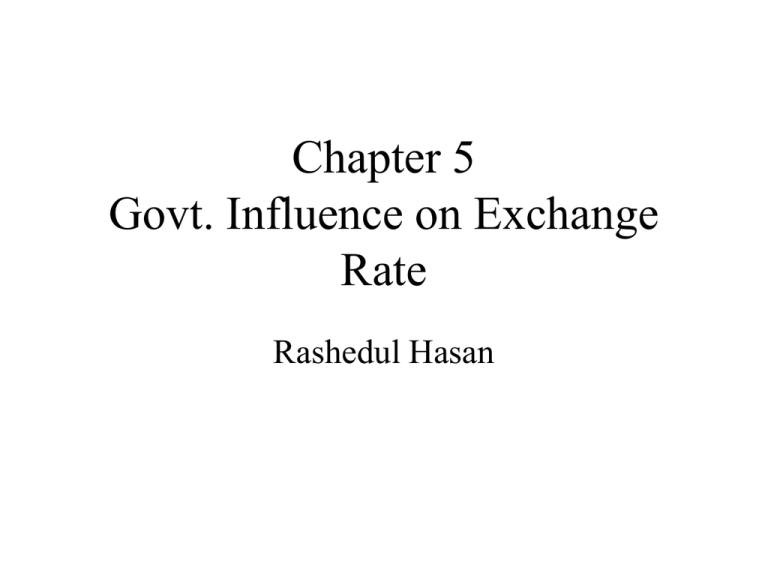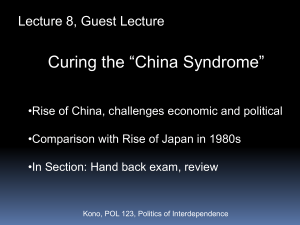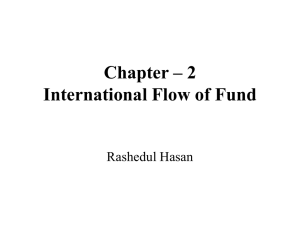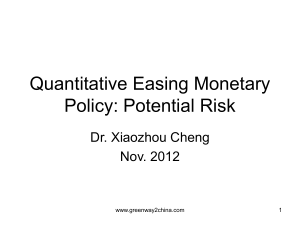File
advertisement

Chapter 5 Govt. Influence on Exchange Rate Rashedul Hasan Exchange Rate Systems • • • • Exchange rate systems normally fall into one of the following categories: Fixed Freely floating Managed float Pegged Fixed Exchange Rate System In a fixed exchange rate system, exchange rates are either held constant or allowed to fluctuate only within very narrow bands. • The Bretton Woods era (1944-1971) fixed each currency’s value in terms of gold. • The 1971 Smithsonian Agreement which followed merely adjusted the exchange rates and expanded the fluctuation boundaries. The system was still fixed. Advantages of Fixed Exchange Rate System • In a fixed exchange rate environment MNCs may be able to engage in International trade without worrying about the future exchange rate. Therefore, Work becomes easier for the MNCs. • For example, when General Motors (GM) imported material for foreign countries during the BrettonWood era, it could anticipate the amount of Dollar it would need to pay the import bill. Disadvantages of Fixed Exchange Rate System • There is still risk that the Government will alter the value of specific currencies. Although the MNCs are not exposed to continual movement of an exchange rate, it does face the possibility that its Govt. will devalue or revalue its currency. • Another disadvantage is each country may become more vulnerable to the economic conditions in other countries. Freely Floating Exchange Rate System In a freely floating exchange rate system, exchange rates are determined solely by market forces. A freely floating exchange rate system adjusts on a continual basis in response to demand and supply conditions for the currency. Advantages of Freely Floating Exchange Rate System • Each country may become more insulated against the economic problems in other countries. • Central bank interventions that may affect the economy unfavorably are no longer needed. • Governments are not restricted by exchange rate boundaries when setting new policies. • Less capital flow restrictions are needed, thus enhancing the efficiency of the financial market. Disadvantages of Freely Floating Exchange Rate System • MNCs may need to devote substantial resources to managing their exposure to exchange rate fluctuations. • The country that initially experienced economic problems (such as high inflation, increasing unemployment rate) may have its problems compounded. Managed Float Exchange Rate System In a managed (or “dirty”) float exchange rate system, exchange rates are allowed to move freely on a daily basis and no official boundaries exist. However, governments may intervene to prevent the rates from moving too much in a certain direction. Managed Float Exchange Rate System At times the Govt. of various countries like Brazil, Russia, South Koria, and Venezuela have imposed bands around their currency ti limit its degree of mmovement. Later, however, they removed the bands when they found they could not maintain the currency’s value within the bands. The one disadvantage associated with it that, a government may manipulate its exchange rates such that its own country benefits at the expense of others. Pegged Exchange Rate System In a pegged exchange rate system, the home currency’s value is pegged to a foreign currency or to some unit of account, and moves in line with that currency or unit against other currencies. Some Asian countries such as Malaysia and Thailand had pegged their currency’s value to the dollar. During the asian crisis, though, they were unable to maintain the peg and allowed their currencies to float against dollar. Pegged Exchange Rate System The European Economic Community’s snake arrangement (1972-1979) pegged the currencies of member countries within established limits of each other. The European Monetary System which followed in 1979 held the exchange rates of member countries together within specified limits and also pegged them to a European Currency Unit (ECU) through the exchange rate mechanism (ERM). The ERM experienced severe problems in 1992, as economic conditions and goals varied among member countries. Pegged Exchange Rate System In 1994, Mexico’s central bank pegged the peso to the U.S. dollar, but allowed a band within which the peso’s value could fluctuate against the dollar. By the end of the year, there was substantial downward pressure on the peso, and the central bank allowed the peso to float freely. Government Intervention Each country has a government agency (called the central bank) that may intervene in the foreign exchange market to control the value of the country’s currency. In the United States, the Federal Reserve System (Fed) is the central bank. In the Bangladesh, Bangladesh Bank is the central bank. • To link to the websites of the central banks around the world, visit http://www.bis.org/cbanks.htm. Reasons for Govt. Intervention Central banks manage exchange rates, • to smooth exchange rate movements, • to establish implicit exchange rate boundaries, and/or • to respond to temporary disturbances. Smooth exchange rate movements If a central bank is concerned that its economy will be affected by abrupt movements in its home currency’s value, it may attempt to smooth the currency movement over time. It may encourage International trade by reducing exchange rate uncertainty. Moreover, smoothing currency movements may reduce fears in the financial markets and speculative activities that could cause a major decline in a currency’s value. Establish implicit exchange rate boundaries Some central bank attept to maintain their home currency rates within some unoficial or implicit boundaries. Analysts are commonly quoted as forecasting that a currency will not fall bellow or rise above a particular benchmark value because the central bank would intervane to prevent that. Respond to temporary disturbances In some cases, a central bank may intervane to insulate a currency’s value from a temporary disturbance. Types of Intervantion Direct vs. Indirect Intervantion Direct intervention refers to the exchange of currencies that the central bank holds as reserves for other currencies in the foreign exchange market. By “flooding the marke with dollars” in this manner, the central bank of U.S. puts pressure on the dollar. If the central bank of U.S. wants to strengthen the dollar, it can exchange foreign currencies for dollars in foreign exchange market, thereby putting upward pressure on the dollar. Direct intervention is usually most effective when there is a co-ordinated effort among central banks. The effect on direct intervention on the value of the British pound are illustrated as follows Fed exchanges $ for £ to strengthen the £ Value of £ V2 V1 S1 D2 D1 Quantity of £ Fed exchanges £ for $ to weaken the £ Value of £ V1 V2 S1 S2 D1 Quantity of £ Nonsterilized intervention vs. Sterilized intervention Nonsterilized When a central bank intervenes in the foreign exchange market without adjusting for the change in money supply, it is said to engaged in nonsterilized intervention. For example, if the Federal Reserve bank exchanges ollars for foreign currencies in in the foreign exchange market in an attempt to strengthen foreign currencies (weaken dollar), the dollar money supply will increase. Nonsterilized Intervention Federal Reserve To Strengthen the C$: $ C$ Banks participating in the foreign exchange market Federal Reserve To Weaken the C$: $ C$ Banks participating in the foreign exchange market Sterilized intervention In a sterilized intervention, Treasury securities are purchased or sold at the same time to maintain the money supply. For example, if the Federal Reserve Bank desires to strengthen foreign currencies (weaken the dollar) without affecting the dollar money supply it may either exchange dollars for foreign currencies or sells some of its holdings of Treasury securities for dollars. The net effect is an increase in investor’s holdings of Treasury securities and a decrease in bank foreign currency balance. Sterilized Intervention T- securities Federal Reserve To Strengthen the C$: $ C$ $ Banks participating in the foreign exchange market $ Federal Reserve To Weaken the C$: $ C$ Financial institutions that invest in Treasury securities T- securities Banks participating in the foreign exchange market Financial institutions that invest in Treasury securities Indirect Intervantion Central banks can also engage in indirect intervention by influencing the factors that determine the value of a currency. For example, the Fed may attempt to increase interest rates (and hence boost the dollar’s value) by reducing the U.S. money supply. Governments may also use foreign exchange controls (such as restrictions on currency exchange) as a form of indirect intervention. Exchange Rate Target Zones Many economists have criticized the present exchange rate system because of the wide swings in the exchange rates of major currencies. Some have suggested that target zones be used, whereby an initial exchange rate will be established with specific boundaries (that are wider than the bands used in fixed exchange rate systems). Exchange Rate Target Zones The ideal target zone should allow rates to adjust to economic factors without causing wide swings in international trade and fear in the financial markets. However, the actual result may be a system no different from what exists today. Intervention as a Policy Tool Like tax laws and money supply, the exchange rate is a tool which a government can use to achieve its desired economic objectives. A weak home currency can stimulate foreign demand for products, and hence local jobs. However, it may also lead to higher inflation. A strong currency may cure high inflation, since the intensified foreign competition should cause domestic producers to refrain from increasing prices. However, it may also lead to higher unemployment. Currency Boards A currency board is a system for maintaining the value of the local currency with respect to some other specified currency. For example, Hong Kong has tied the value of the Hong Kong dollar to the U.S. dollar (HK$7.8 = $1) since 1983, while Argentina has tied the value of its peso to the U.S. dollar (1 peso = $1) since 1991. For a currency board to be successful, it must have credibility in its promise to maintain the exchange rate. Currency Boards It has to intervene to defend its position against the pressures exerted by economic conditions, as well as by speculators who are betting that the board will not be able to support the specified exchange rate. Dollarization Dollarization refers to the replacement of a local currency with U.S. dollars. Dollarization goes beyond a currency board, as the country no longer has a local currency. For example, Ecuador implemented dollarization in 2000.








